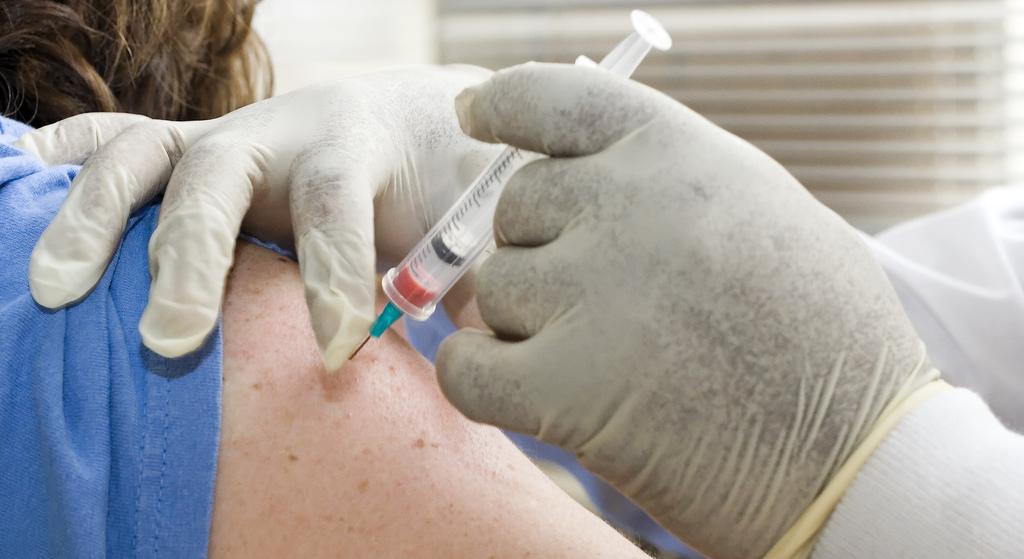The percentage of people receiving a flu vaccine increased slightly in adults and in health workers during the past flu season, but rates dropped a bit among pregnant women and held steady in children, federal officials said today in their annual push to promote the preventive measure.
New data on flu vaccine uptake were reported by the Centers for Disease Control and Prevention (CDC) in several reports in its publication Morbidity and Mortality Weekly Report (MMWR) and in a press conference today sponsored by the National Foundation for Infectious Diseases (NFID).
Vaccination coverage in the general population, however, remains below 50%. The new figures come from a season in which effectiveness of the flu vaccine was only 19%, a 9-year low.
Despite the low effectiveness numbers, officials reminded the public of the importance of the vaccine. "Vaccination is the single most important step people can take to protect themselves from influenza," said CDC Director Tom Frieden, MD, MPH, in an NFID news release. "Flu can be serious, and it kills tens of thousands of Americans each year."
Experts noted that the composition of the flu vaccine has changed since last year to match what officials predict will be the circulating strains in the upcoming flu season.
Uptake by age-group
Vaccination coverage in all people 6 months or older was 47.1% in 2014-15, up only about a percentage point from 2013-14. The rate in children held fairly steady, at 59.3%, while the rate in adults rose 1.4 percentage points, to 43.6%. Girls and women were more likely to get vaccinated (49.6%) compared with their male counterparts (44.7%).
Adults with the largest increase in coverage were in the 50 and older age-group; their increase was 1.7 percentage points. Coverage among those 50 to 64 was 47.0%, and for people 65 and older it was 66.7%. The latter group is often hardest hit by seasonal influenza.
Vaccine uptake in kids remained level across all age-groups compared with last year. Those 6 to 24 months old had the highest rate, 74.6%.
Non-Hispanic black populations showed the largest increase in coverage, with a 2.3 percentage point rise, to 43.8%. Asian Americans had the highest uptake in the CDC's ethnic comparison, at 51.0%; whites were second, at 48.5%. The rate held steady in the former group and inched up about a percentage point in the latter.
The Healthy People 2020 target for influenza vaccine uptake in both adults and children is 70%.
Healthcare worker vaccinations
Flu vaccine uptake rose about 2 percentage points in healthcare workers (HCWs), to 77.3%, the CDC noted in an MMWR report.
Coverage remained high among nurses, physicians, and nurse practitioners/physician assistants: 89.0%, 88.9%, and 87.0%, respectively. But outside of allied professionals, those groups also saw the largest declines among HCWs: drops of 1.5, 3.3, and 2.6 percentage points, respectively. Uptake in allied health professionals dropped 6.1 percentage points, to 81.3%.
Pharmacists led all HCWs in coverage rates, at 95.3%, and they also saw the biggest gain—an impressive 9.6 percentage points.
Overall HCW coverage was brought down by rates in nonclinical HCWs and in aides and assistants. Those groups had coverage of 75.2% and 64.4%, respectively, but each realized gains of almost 7 percentage points.
The Healthy People 2020 target for flu vaccine uptake in HCWs is 90%.
Rates down in pregnant women
In a separate MMWR report, the CDC noted that flu vaccine coverage in pregnant women fell 1.9 percentage points from two seasons ago, to 50.3%. Vaccination before pregnancy fell 2.3 percentage points and was fairly flat during pregnancy.
The percentage of pregnant women whose physicians recommended a flu vaccine stayed about the same, at 64.9%. And 67.9% of patients who received this advice got the vaccine. That rate was 70.5% in 2013-14.
The Healthy People 2020 target for flu vaccine uptake in pregnant women is 80%.
Pneumococcal vaccine
The NFID event also emphasized the importance of everyone 65 years and older—and adults with high-risk conditions—getting one of the two pneumococcal vaccines approved in the United States.
Earlier this month, the CDC updated its pneumococcal vaccine recommendations for healthy adults age 65 years and older, calling for a minimum of 1 year between the two types of pneumococcal vaccines, replacing the previously recommended 6- to 12-month interval.
The change was made to sync the interval between pneumococcal vaccinations.
See also:
Sep 17 NFID news release
Sep 17 CDC data by age-group
Sep 18 MMWR report on HCW uptake
Sep 18 MMWR report on coverage in pregnant women
Sep 18, 2014, CDC news story on 2013-14 numbers



















